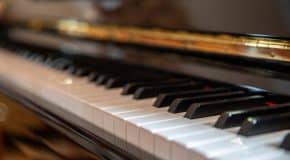If you are in the market for a digital piano to start piano lessons, with the number of choices out there, it can be difficult to feel that you are making the best purchase decision. Let’s say you already have your price range defined, but you want to get the best instrument for your dollar. Here are the things you want to consider when comparing instruments and buying a digital piano.
Making Sure the Instrument Has the Basics

Whether you are purchasing a $300 digital piano or a $1,500 digital piano, the first step it to make sure that the instrument has all the basics of what you will need to get it up and running. One important point with which to start is making sure that the instrument has built in speakers and does not require an amp to make sound. If you are willing to purchase a keyboard amp separately, then it is fine to choose a model that does not have internal speakers, but most students and musicians like the ability to push the power button and have the instrument play and not have to set up an amp as well.
You will also want to make sure that there is a foot pedal that can be connected to the digital piano, and most of the time, one is included with the purchase. As a personal note, I would not purchase a digital piano for lessons if it does not have 88-keys, but again, that’s an individual preference. The reason is that there are so many great deals on full-sized keyboards that buying something smaller is not really saving a lot when thinking about the quality of the instrument. Along the same lines, weighted (or ‘velocity –sensitive’) keys are important in developing good technique if performing on an acoustic piano, like in recital situations, and I would only purchase an option that mimics the feel of an acoustic piano.
The ‘Feel’ of the Instrument
Once you’re sure the instrument has all the features listed above, now it’s time to start testing out the digital piano. If you go to a Guitar Center, for example, play around with different brands in your price range and see what the differences are in the way the keys feel. Even to a novice, some instruments will draw you in more than others. You want to get the most authentic feel for your budget, so even comparing to an acoustic piano is a good idea. Sales reps in stores like these can also help in telling you which option is closer to the real deal, but overall, you want to go with the heavier, less-plastic feeling keys amongst available options. If ordering online, that’s fine too, just be aware that you should probably read a review or two that will mention these types of details.
Shop for a Good Deal!
This may seem like an obvious tip, but generally, the more expensive the digital piano is, the better its quality. This is not always true for acoustic pianos, but in the keyboard realm, it’s pretty consistent. If you pay more (or the original price is more), you’re going to get a more authentic representation of a traditional piano. So, you should look for digital piano options in your price range that are on sale from a higher price, and trust me, there are a ton of them! One reason for these crazy mark-downs is that music instrument stores have to get rid of a certain amount of inventory a year, and they will start trying to move products accordingly. For example, I was helping a student shop for a digital piano online, and we were able to find her a $600 digital piano that was marked down to $200, which means she got a much better instrument than her budget would reflect if the digital piano were new and $200. Instrument retailers also have used digital pianos from time to time, and if you buy one at a store, you at least have the guarantee that the keyboard is in good working order.
Buying a Digital Piano
Now that you feel confident in the fact that you have a great instrument, you’re all set to start piano lessons and get playing! That’s it on digital pianos, and I hope you found this information helpful. Stay tuned for a follow up on what quality points to look for when buying an acoustic piano.


